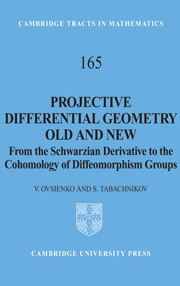 Projective Differential Geometry Old and New
Projective Differential Geometry Old and New Published online by Cambridge University Press: 14 August 2009
What are geometric objects? On the one hand, curves, surfaces, various geometric structures; on the other, tensor fields, differential operators, Lie group actions. The former objects originated in classical geometry while the latter ones are associated with algebra. Both points of view are legitimate, yet often separated.
This chapter illustrates unity of geometric and algebraic approaches. We study geometry of a simple object, the projective line. Such notions as non-degenerate immersions of a line in projective space and linear differential operators on the line are intrinsically related, and this gives two complementary viewpoints on the same thing.
Following F. Klein, we understand geometry in terms of group actions. In the case of the projective line, two groups play prominent roles: the group PGL(2,ℝ) of projective symmetries and the infinite-dimensional full group of diffeomorphisms Diff(ℝℙ1). We shall see how these two types of symmetry interact.
Invariant differential operators on ℝℙ1
The language of invariant differential operators is an adequate language for differential geometry. The best-known invariant differential operators are the de Rham differential of differential forms and the commutator of vector fields. These operators are invariant with respect to the action of the group of diffeomorphisms of the manifold. The expressions that describe these operations are independent of the choice of local coordinates.
To save this book to your Kindle, first ensure [email protected] is added to your Approved Personal Document E-mail List under your Personal Document Settings on the Manage Your Content and Devices page of your Amazon account. Then enter the ‘name’ part of your Kindle email address below. Find out more about saving to your Kindle.
Note you can select to save to either the @free.kindle.com or @kindle.com variations. ‘@free.kindle.com’ emails are free but can only be saved to your device when it is connected to wi-fi. ‘@kindle.com’ emails can be delivered even when you are not connected to wi-fi, but note that service fees apply.
Find out more about the Kindle Personal Document Service.
To save content items to your account, please confirm that you agree to abide by our usage policies. If this is the first time you use this feature, you will be asked to authorise Cambridge Core to connect with your account. Find out more about saving content to Dropbox.
To save content items to your account, please confirm that you agree to abide by our usage policies. If this is the first time you use this feature, you will be asked to authorise Cambridge Core to connect with your account. Find out more about saving content to Google Drive.